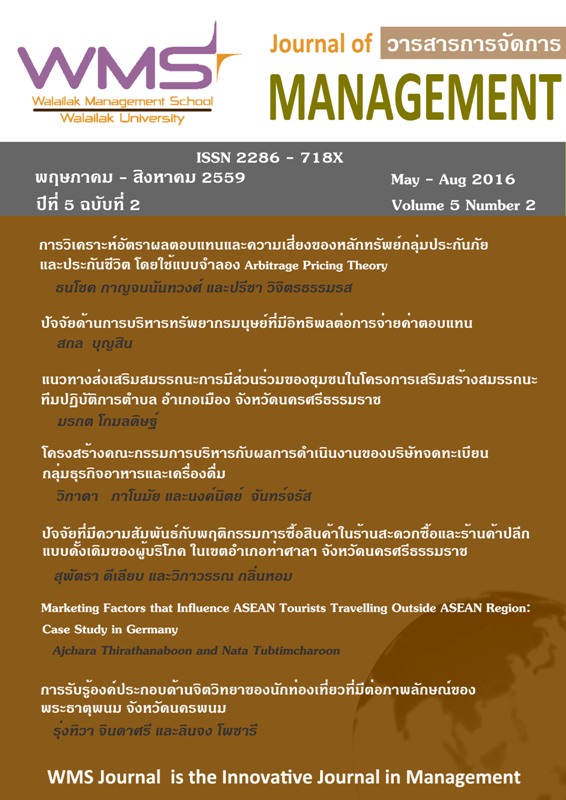Human resource management factors that affected the compensation
Main Article Content
Abstract
Article Details
References
กิ่งพร ทองใบ. (2553). ระบบค่าตอบแทนสมัยใหม่ จากวิชาการสู่วิชาชีพ. กรุงเทพฯ: เอช อาร์ เซ็นเตอร์.
ภาณุภาคย์ พงศ์อติชาต. (2549). ความสมดุลระหว่างชีวิตและการทำงาน. สืบค้นเมื่อ12 มีนาคม 2557 สืบค้นจากhttp://www.ocsc.go.th/ocsc/th/uploads/File/docutianment/issue/hr_dictionary/hr_dic_wlb01.pdf
รัตกัมพล พันธุ์เพ็ง. (2547). ความสัมพันธ์ระหว่างการรับรู้ สภาพแวดล้อมในการทำงาน ความเหนื่อยล้าทางจิตใจและสุขภาพของ พนักงานโรงงานอุตสาหกรรมผลิตเลนซ์. วิทยานิพนธ์ปริญญามหาบัณฑิต, มหาวิทยาลัยเกษตรศาสตร์.
เรืองวิทย์ เกษสุวรรณ. (2548). การบริหารค่าจ้างและเงินเดือน. พิมพ์ครั้งที่ 3. กรุงเทพฯ: ซีเอ็ด ยูเคชั่น.
สุกัญญา ตันวนรัตน์สกุล. (2547). ความสมดุลในชีวิตของพนักงานในสถานประกอบการที่ประกอบธุรกิจประเภทนำเข้า ส่งออก และนายหน้าตัวแทนระหว่างประเทศ. วิทยานิพนธ์ปริญญามหาบัณฑิต มหาวิทยาลัยธรรมศาสาตร์. กรุงเทพฯ: มหาวิทยาลัยธรรมศาสตร์.
สุชาดา สีสุวรรณ. (2546). ความสัมพันธ์ระหว่างพฤติกรรมการเป็นสมาชิกที่ดีขององค์การกับความพึงพอใจสภาพแวดล้อมในการทำงานและผลการปฏิบัติงานของพนักงาน บริษัท แองโกล-ไทย จำกัด. วิทยานิพนธ์ปริญญามหาบัณฑิต มหาวิทยาลัยเกษตรศาสตร์. กรุงเทพฯ: มหาวิทยาลัยเกษตรศาสตร์.
สุภมาส อังศุโชติ และคณะ. (2554). สถิติวิเคราะห์สำหรับการวิจัยทางสังคมศาสตร์และพฤติกรรมศาสตร์ : เทคนิคการใช้โปรแกรม LISREL. พิมพ์ครั้งที่ 3. นนทบุรี: มหาวิทยาลัยสุโขทัยธรรมาธิราช.
Adams, J. (1965). Injustice in Social Exchange.
In Advances in Experimental Social Psychology. Vol. 19. L. Berkowitz, ed. New York: Academic Press.
Albertsen, K.; Kauppinen, K.; Grimsmo, A.; Sørensen, B. A.; Rafnsdóttir, G. L. and Tómasson, K. (2007). Working Time Arrangements and Social Consequences What Do We Know? Report. No. 607. Kobenhavn: Nordic Council of Ministers.
Byars, Lloyd L. and Leslie W. Rue. (1997). Human Resource Management. 5th ed. Boston: lrwin McGraw-Hill.
Carvalho, V. S., & Chambel, M. J. (2014). Work-to-family enrichment and employees’ well-being: High performance work system and job characteristics. Social Indicators Research, 119, 373–387. doi:0.1007/s11205-013-0475-8
Coats, D. and Lekhi, R. (2008). Good Work: Job Quality in a Changing Economy. London: The Work Foundation.
Christina A. et al. (2009). Work environment risk
factors for injuries in wood processing. Journal of Safety Research. 40 (4). pp. 247-255.
Eisenhardt, K. M. (1989). Agency Theory: an Assessment and Review. Academy of Management Review. 14 (1): 57-74.
Ekbladh, E., Thorell, L.., & Haglund, L. (2010). Perceptions of the work environment among people with experience of long term sick leave. Work, 35, 125-136.
Gerhart, B. and Rynes, S. L. (2003). Compensation: Theory, Evidence, and Strategic Implications. Thousand Oaks, CA: Sage.
Gomez-Mejia, Luis R.; Balkin, David B. and Cardy, Robert L. (2004). Managing Human Resources. 4th ed. Upper Saddle River, N.J.: Prentice Hall.
Greenberg, J. and Baron, R. A. (2000). Behavior
in Organization. 7th ed. Upper Saddle River, N.J.: Prentice Hall.
Hackman, J. R.; Lawler, Edword E. and Porter,
Lyman W. (1977). Perspectives on Behavior in Organizations. New York: McGraw-Hill.
Hackman, J. R. and Oldham, G. R. (1980). Work
Redesign. New York: Addison-Wesley.
Jones, F.; Burke, R. and Westman, M. eds.
(2006). Work-life Balance: a Psychological Perspective. England: Psychology Press.
Karimi L. (2009). Predicting employees' well-being using work–family conflict and job strain models. Stress and Health, 27 (2). 111–122.
Milkovich, George, T.; Newman, Jerry M. and Gerhart, B. (2011). Compensation. 10th ed. New York: McGraw-Hill.
Mondy, R. Wayne. (2011). Human Resource
Management. 12th ed. Upper Saddle River, N.J.: Pearson Prentice Hall.
Smith, T. E.; Roland, C. C.; Havens, M. D. and
Hoyt, J. A. (1992). The Theory and Practice of Challenge Education. Dubuque, IO: Kendall-Hunt.
Tausig, Mark, and Fenwick, Rudy. (2001). Unbinding Time: Alternate work Schedules and work-Life Balance. Journal of family and Economic Issues, 22 (2), 101-118.
van den Berg PT. (2011). Characteristics of the work environment related to older employees' willingness to continue working: intrinsic motivation as a mediator. Psychological Reports: Volume 109, Issue. 174-186.
Van Eerde, W. and Thierry, H. (1996). Vroom’s
Expectancy Models and Work-Related Criteria: a Meta-Analysis. Journal of Applied Psychology. 81 (5): 575-586.


